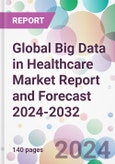Global Big Data in Healthcare Market Outlook
The global big data in healthcare market size was valued at USD 34 billion in 2023, driven by rising prevalence for predictive analytics across the globe. The market size is anticipated to grow at a CAGR of 14% during the forecast period of 2024-2032 to achieve a value of USD 110.4 billion by 2032.Big Data in Healthcare: Introduction
Big Data in healthcare refers to the vast amounts of health-related data collected from various sources, including electronic health records (EHRs), medical imaging, genomic sequencing, wearables, and medical devices. This data is analyzed to uncover insights that can improve patient outcomes, enhance operational efficiency, predict epidemics, support clinical decisions, and personalize medical treatments. By leveraging advanced analytics, machine learning, and artificial intelligence, healthcare providers can make more informed decisions, leading to better care and reduced costs.Key Trends in the Global Big Data in Healthcare Market
The use of predictive analytics is growing, enabling healthcare providers to anticipate patient deterioration, predict disease outbreaks, and improve patient outcomes through proactive care.Big Data is facilitating the shift towards personalized medicine, where treatments and healthcare plans are tailored to individual genetic profiles, lifestyle, and health history.
There's an increasing focus on interoperability and the integration of disparate data sources, including EHRs, patient-generated data, and genomic data, to create a more comprehensive view of patient health.
The integration of AI and machine learning technologies with Big Data is accelerating, offering advanced diagnostics, treatment recommendations, and operational efficiencies in healthcare settings.
As the volume of healthcare data grows, so does the focus on ensuring data privacy and security. Regulatory compliance and the development of secure data-sharing frameworks are key priorities.
The expansion of telehealth and remote patient monitoring generates vast amounts of data, contributing to more dynamic and real-time patient care models.
Big Data is increasingly used for population health management, aiding in the identification of health trends, risk factors, and the development of targeted intervention programs.
Healthcare organizations are leveraging Big Data to optimize operations, reduce waste, and lower costs, while maintaining or improving care quality.
Global Big Data in Healthcare Market Segmentation
Market Breakup by Components
- Software
- Electronic Health Record Software
- Practice Management
- Workforce Management
- Services
Market Breakup by Mode of Deployment
- On - Premises
- Cloud
Market Breakup by Analytics Type
- Descriptive
- Predictive
- Prescriptive
Market Breakup by Applications
- Clinical Data Analytics
- Financial Analytics
- Operational Analytics
Market Breakup by End User
- Hospitals and Clinics
- Finance and Insurance Agencies
- Research Organizations
- Others
Market Breakup by Region
- North America
- Europe
- Asia Pacific
- Latin America
- Middle East and Africa
Global Big Data in Healthcare Market Overview
In North America, the Big Data in healthcare market is highly advanced, driven by technological innovation, widespread adoption of electronic health records (EHRs), and significant investments in health IT infrastructure. The region leads in the application of analytics and artificial intelligence (AI) to improve patient care, operational efficiency, and personalized medicine. Regulatory frameworks and initiatives promoting data sharing and privacy protection also shape the market dynamics.Europe's market benefits from strong healthcare systems, robust data protection regulations like the GDPR, and a focus on research and innovation. There's a growing emphasis on interoperability and the secure exchange of health information across borders, facilitating the use of Big Data for public health monitoring, clinical research, and personalized healthcare. Collaborative projects and funding at the EU level support advancements in health data analytics.
The Asia-Pacific region exhibits rapid growth in the Big Data in healthcare market, driven by increasing healthcare digitization, rising investments in healthcare infrastructure, and a growing focus on telemedicine and mobile health applications. Countries like China, Japan, and South Korea are investing heavily in AI and machine learning to address healthcare challenges, improve disease surveillance, and enhance patient outcomes. However, the region faces challenges related to data standardization and integration.
Global Big Data in Healthcare Market: Competitor Landscape
The key features of the market report include patent analysis, grants analysis, clinical trials analysis, funding and investment analysis, partnerships, and collaborations analysis by the leading key players.- Allscripts Healthcare Solutions, Inc.
- Cerner Corp.
- Optum Inc.
- Premier, Inc.
- McKesson Corporation
- Hewlett Packard Enterprise (HPE)
- International Business Machines Corporation (IBM)
- Microsoft Corporation
- Oracle Corp.
- GE Healthcare
This product will be delivered within 5-7 business days.
Table of Contents
1 Preface
3 Global Big Data in Healthcare Market Overview
4 Global Big Data in Healthcare Market Landscape
5 Global Big Data in Healthcare Market Dynamics
6 Global Big Data in Healthcare Market Segmentation
7 North America Big Data in Healthcare Market
8 Europe Big Data in Healthcare Market
9 Asia Pacific Big Data in Healthcare Market
10 Latin America Big Data in Healthcare Market
11 Middle East and Africa Big Data in Healthcare Market
12 Funding and Investment Analysis
13 Partnership and Collaborations Analysis
15 Supplier Landscape
16 Global Big Data in Healthcare Market - Distribution Model (Additional Insight)
18 Company Competitiveness Analysis (Additional Insight)
19 Payment Methods (Additional Insight)
Companies Mentioned
- Allscripts Healthcare Solutions Inc.
- Cerner Corp.
- Optum Inc.
- Premier Inc.
- McKesson Corporation
- Hewlett Packard Enterprise (HPE)
- International Business Machines Corporation (IBM)
- Microsoft Corporation
- Oracle Corp.
- GE Healthcare
Methodology

LOADING...
Table Information
| Report Attribute | Details |
|---|---|
| No. of Pages | 140 |
| Published | February 2024 |
| Forecast Period | 2024 - 2032 |
| Estimated Market Value ( USD | $ 38.7 Billion |
| Forecasted Market Value ( USD | $ 110.4 Billion |
| Compound Annual Growth Rate | 14.0% |
| Regions Covered | Global |
| No. of Companies Mentioned | 10 |









